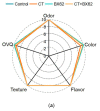The Effect of Lactiplantibacillus plantarum BX62 Alone or in Combination with Chitosan on the Qualitative Characteristics of Fresh-Cut Apples during Cold Storage
- PMID: 34835529
- PMCID: PMC8618497
- DOI: 10.3390/microorganisms9112404
The Effect of Lactiplantibacillus plantarum BX62 Alone or in Combination with Chitosan on the Qualitative Characteristics of Fresh-Cut Apples during Cold Storage
Abstract
In order to explore whether beneficial lactic acid bacteria (LAB) could prolong the shelf life and improve the quality of fresh-cut apples, Lactiplantibacillus plantarum BX62, which was isolated from traditional fermented yak yogurt, and chitosan (CT), were applied to fresh-cut apples, subsequently stored at 4 °C. On days 0, 2, 4, 6, and 8, apple slices were taken for physicochemical, microbiological analysis, and sensory evaluation. The results showed that apple slices coated with L. plantarum BX62 (8 log CFU/mL) presented lower weight loss and browning rate, higher DPPH scavenging capacity, and achieved more effective inhibition of polyphenol oxidase (PPO) and peroxidase (POD) activities compared to the control samples. The application of CT alone or in combination with L. plantarum BX62 resulted in a significant reduction in aerobic mesophilic bacteria (AMB), aerobic psychrophilic bacterial (APB), yeast and molds (YAMs) counts (2.31 log CFU/g for AMB, 2.55 for APB, and 1.58 for YAMs). In addition, L. plantarum BX62 coated apples showed acceptable sensory properties in terms of color, flavor, taste, texture, and overall visual quality during 8 d of storage. On this basis, L. plantarum BX62 could be used as an excellent bio-preservative to extend the shelf life and improve the quality of fresh-cut apples.
Keywords: Lactiplantibacillus plantarum; bio-preservative; chitosan; fresh-cut apples.
Conflict of interest statement
The authors declare no conflict of interest.
Figures








Similar articles
-
Utilizing Xanthan Gum Coatings as Probiotic Bacteria Carriers to Enhance Postharvest Quality and Antioxidants in Fresh-Cut Cantaloupe and Honeydew (Cucumis melo L.) Melons.Foods. 2024 Mar 20;13(6):940. doi: 10.3390/foods13060940. Foods. 2024. PMID: 38540930 Free PMC article.
-
Bioactive edible film based on Konjac glucomannan and probiotic Lactobacillus plantarum strains: Physicochemical properties and shelf life of fresh-cut kiwis.J Food Sci. 2021 Feb;86(2):513-522. doi: 10.1111/1750-3841.15568. Epub 2021 Jan 7. J Food Sci. 2021. PMID: 33415755
-
Selenium application during fruit development can effectively inhibit browning of fresh-cut apples by enhancing antioxidant capacity and suppressing polyphenol oxidase activity.J Plant Physiol. 2023 Aug;287:154050. doi: 10.1016/j.jplph.2023.154050. Epub 2023 Jul 10. J Plant Physiol. 2023. PMID: 37441911
-
Viability of Lactobacillus plantarum on Fresh-Cut Chitosan and Alginate-Coated Apple and Melon Pieces.Front Microbiol. 2018 Oct 23;9:2538. doi: 10.3389/fmicb.2018.02538. eCollection 2018. Front Microbiol. 2018. PMID: 30405587 Free PMC article.
-
Chemical inhibition of polyphenol oxidase and cut surface browning of fresh-cut apples.Crit Rev Food Sci Nutr. 2023;63(27):8737-8751. doi: 10.1080/10408398.2022.2061413. Epub 2022 Apr 13. Crit Rev Food Sci Nutr. 2023. PMID: 35416745 Review.
Cited by
-
Screening of Lactiplantibacillus plantarum NML21 and Its Maintenance on Postharvest Quality of Agaricus bisporus through Anti-Browning and Mitigation of Oxidative Damage.Foods. 2024 Jan 3;13(1):168. doi: 10.3390/foods13010168. Foods. 2024. PMID: 38201195 Free PMC article.
-
Antioxidant Activity and Microbial Quality of Freeze-Dried, Lactic Acid Fermented Peach Products.Molecules. 2025 May 29;30(11):2360. doi: 10.3390/molecules30112360. Molecules. 2025. PMID: 40509247 Free PMC article.
-
The Impacts of Lactiplantibacillus plantarum on the Functional Properties of Fermented Foods: A Review of Current Knowledge.Microorganisms. 2022 Apr 15;10(4):826. doi: 10.3390/microorganisms10040826. Microorganisms. 2022. PMID: 35456875 Free PMC article. Review.
References
-
- Yousuf B., Qadri O.S., Srivastava A.K. Recent Developments in Shelf-Life Extension of Fresh-Cut Fruits and Vegetables by Application of Different Edible Coatings: A Review. LWT Food Sci. Technol. 2018;89:198–209. doi: 10.1016/j.lwt.2017.10.051. - DOI
-
- Mantilla N., Castell-Perez M.E., Gomes C., Moreira R.G. Multilayered Antimicrobial Edible Coating and Its Effect on Quality and Shelf-Life of Fresh-Cut Pineapple (Ananas comosus) LWT Food Sci. Technol. 2013;51:37–43. doi: 10.1016/j.lwt.2012.10.010. - DOI
-
- Iglesias M.B., Echeverría G., Viñas I., López M.L., Abadias M. Biopreservation of Fresh-Cut Pear Using Lactobacillus rhamnosus GG and Effect on Quality and Volatile Compounds. LWT Food Sci. Technol. 2018;87:581–588. doi: 10.1016/j.lwt.2017.09.025. - DOI
LinkOut - more resources
Full Text Sources
Other Literature Sources
Miscellaneous

